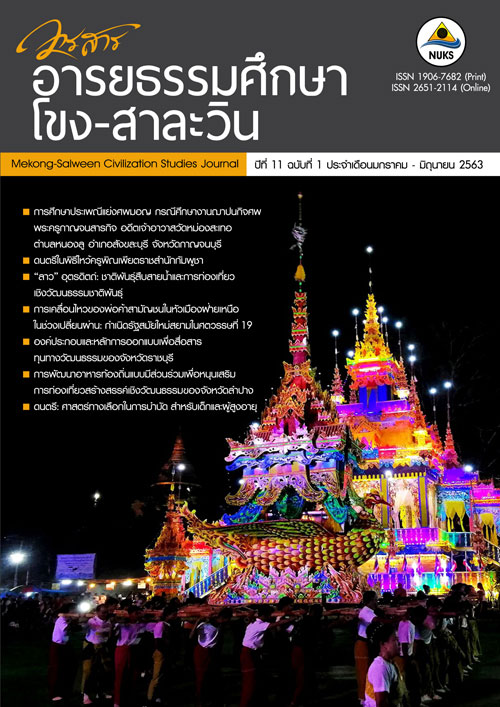Music in Wai Khru Pin Peat Ceremony in the Royal Court of Cambodia
Main Article Content
Abstract
The purpose of this research is to study the history and development, including rituals and songs used in the Wai Khru Pin Peat (Master Worship) Ceremony of the Royal Court of Cambodia. The researcher employed a qualitative research method to collect the fieldwork data in the 2016 waikhru ceremony at the Secondary School of Fine Arts, Thailand, and the additional data at Royal University of Fine Arts in the Capital city of Cambodia, Phnom Penh, in 2016. It was found that the Pin Peat ensemble had been developed from the contemporary vision of the Cambodian royal philosophers and religious practice of Brahminism which was, at that time, called the music of the religion or the music of the philosophers. The Pin Peat ensemble was previously originated from the Plengpin ensemble of Nakhon Panom peroid. Also, in the Prehistoric Era of Cambodia, there was the ensemble known as Wongkongskorn that used the percussion as the main instrument. Therefore, the Pin Peat ensemble was inaugurated from the Plengpin ensemble and the Wongkongskorn ensemble. As to Wai Khru Pin Peat ceremony, its origin is associated with Dhonta ceremony (ដូនតា) held as an auspicious offering to the music predecessors. Since the Second World War, the ceremony has been adjusted and developed in terms of its rituals and system. For example, those who performed the original ceremony called the plengpin song for a big blessing, having 33 songs in total. However, due to political, war, financial, time, and content factors, the content of the music in the ceremony was shortened to 12 songs which is called a small blessing. Subsequently, the Wai Khru Pin Peat ceremony is divided into 3 parts: 1) the offering to Dhonta, 2) the commemoration of Cambodian music predecessors, and 3) the commemoration of the current music teachers with blessing ceremony. The results of the music analysis showed that the most important melody was the sound group of Pentatonic Scales (F) and Pentatonic (G) which is the key voice of the musical principles. The rhythm is divided into 3 groups: 1) using only small cymbal (Ching) as the rhythm, 2) using the drum (Tabor) and the small cymbal (Ching) as the rhythm, and 3) using small cymbal (Ching), drum (Tabor), and drum (Glong Thad), as the rhythm.
Downloads
Article Details
References
Boapim, S. (1995). Thai heritage. Bangkok: Odeon Store Publisher.
Chandara, Y. (2016, March 30). Interview. Ministry of Culture and Fine Arts, Cambodia.
Daravong, R. (2016, March 29). Interview. Director Secondary School of Fine Arts, Cambodia.
Dorivan, K. (2016, March 29). Interview. RUFA- Royal University of Fine Arts, Cambodia.
Khowdee, S. (2016). San Don Ta tradition. Bangkok: Faculty of Arts, Chulalongkorn University.
Pidokrajt, N. (2010). Wai Khru ceremony in Thai traditional music. (Doctoral dissertation).
Mahidol University, Bangkok.
Pikulsri, C. (2011). Pin Peat-Cambodia’s royal court ceremonial music after A.D. 1993. (Master’s thesis).
Khonkaen University, Khonkaen.
Santasombat, Y. (1997). Human and culture. (2nd ed.). Bangkok: Thammasat University Publisher.
Saret, S. (2016, March 31). Interview. Professional Director Secondary School of Fine Arts, Cambodia.
Sarin H. (2005). Khmer Orchestra (វង់ភ្លេងខ្មែរ). Cambodia: Ministry of Culture and Fine Arts.
Sokhatiyanurak, N. (1999). Musical Form and Analysis. Bangkok: Chulalongkorn University Language
Institute.
Wansiri, N. (2007). Social and cultural anthropology. Bangkok: Expernetbooks.
Wongthes, S. (2010). Ancient Cambodian musical instruments. Bangkok: College of Music Publishing
Mahidol University.


